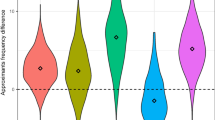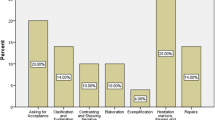Abstract
It has been observed in the literature that stem-final coronal obstruents of nouns in Korean are generally in variation with [s] in the prevocalic position: for example, /pathh-ɨl/ [pathh-ɨl] ~ [pasɨl] ‘field, accusative’. In addition, nouns with final noncoronal stops have variants ending in lenis stops: for example, /iph-e/ [iph-e] ~ [ipe] ‘leaf, locative’. Recent survey and experimental studies reveal that a wide set of coronal obstruents [s, ch, th, c, t] may occur as variants. Moreover, there is an order of preference among them: in general, s >> ch, th >> c, t. This paper first shows that the observed relative preference among variants is matched by the distribution of lexical final obstruents in noun stems. Building on Albright’s Paradigm Learning Model, I provide a unified account for the occurrence of most variants and their relative preference by proposing stochastic rules deriving the paradigmatically related forms of noun stems. In addition, a wug-test is carried out to investigate the productivity of such rules. Results suggest that these rules are productive, providing the evidence for their cognitive presence.
Similar content being viewed by others
References
Ahn Sang-Cheol. (2001) An introduction to Korean phonology. Seoul, Hanshin
Albright, Adam. 2002a. The identification of bases in morphological paradigms. Ph.D dissertation, UCLA.
Albright Adam. (2002b) Islands of reliability for regular morphology: Evidence from Italian. Language 78(4): 684–709
Albright, Adam. 2005. The morphological basis of paradigm leveling. In Paradigms in Phonological Theory, ed. Laura Downing, Tracy Alan Hall, and Renate Raffelsiefen, 17–43. Oxford: Oxford University Press.
Albright, Adam. 2008. Explaining universal tendencies and language particulars in analogical change. In Language universals and language change, ed. Jeff Good, 144–181. Oxford: Oxford University Press.
Albright, Adam, and Bruce Hayes. 2002. Modeling English past tense intuitions with minimal generalization. In Proceedings of the 6th meeting of the ACL special interest group in Computational Phonology, ed. M. Maxwell, 58–69. Philadelphia: ACL.
Albright Adam, Bruce Hayes. (2003) Rules vs. analogy in English past tenses: A computational/experimental Study. Cognition 90: 119–161
Berko Jean. (1958) The child’s learning of English morphology. Word 14: 150–177
Boersma Paul, Bruce Hayes. (2001) Empirical tests of the gradual learning algorithm. Linguistic Inquiry 32(1): 45–86
Bybee Joan. (1995) Regular morphology and the lexicon. Language and Cognitive Processes 10: 425–455
Bybee Joan. (2001) Phonology and language use. Cambridge University Press, Cambridge
Choi, Hyewon. 2004. A survey of standard pronunciation III [phyocunpalum silthecosa III]. Seoul: The National Academy of Korean Language.
Choi Kyung-Ae. (2002) [t] ~ [s] Alternation in Korean Loanwords. Studies in phonetics, phonology and morphology 8(2): 289–302
Davis Stuart, Hyunsook Kang. (2006) English loanwords and the word-final [t] problem in Korean. Language Research 42(2): 253–274
Han Eunjoo. (2002) Optimal paradigms in Korean nominal inflection. Studies in phonetics, phonology and morphology 8(2): 303–322
Hayes, Bruce. 1998. On the richness of paradigms, and the insufficiency of underlying representations in accounting for them. Handout for talk, Stanford University, April 2, 1998.
Hayes Bruce, Zsuzsa Cziraky Londe. (2006) Stochastic phonological knowledge: The case of Hungarian vowel harmony. Phonology 23: 59–104
Jun Jongho, Jeehyun Lee. (2007) Multiple stem-final variants in Korean native nouns and loanwords. Eoneohag 47: 159–187
Kang, Beom-mo, and Kim Hung-gyu. 2004. Frequency analysis of Korean morpheme and word usage 2 [hankwuke hyengtayso mich ehwi sayong pintouy pwunsek 2]. Seoul: Institute of Korean Culture, Korea University.
Kang, Eunji, Ho-Young Lee, and Juwon Kim. 2004. The phonetic realization of syllable codas in Korean. Malsori 49, Journal of the Korean Society of Phonetic Science and Speech Technology: 1–30.
Kang, Yoonjung. 2003a. Sound changes affecting noun-final coronal obstruents in Korean. In Japanese/ Korean Linguistics 12, ed. W. McClure, 128–139. Stanford: CSLI.
Kang, Yoonjung. 2003b. The emergence of phonetic naturalness in an analogical change: Evidence from Korean nouns. Handout for LANYU Forum, New York University, January 31, 2003.
Kang, Yoonjung. 2005. The emergence of the unmarked in an analogical change. Handout from the workshop on phonological typology, Seoul National University, December 9–10, 2005.
Kang, Yoonjung. 2007. Frequency effects and regularization in Korean nouns. Handout from the workshop on variation, gradience and frequency in phonology, Stanford University, July 6–8, 2007.
Kenstowicz, Michael. 1996. Base-identity and uniform exponence: Alternatives to cyclicity. In Current trends in phonology: Models and methods, ed. J. Durand and B. Laks, 363–394. Paris X and Salford: University of Salford Publications.
Kim, Chang-seop. 2001a. On the relationship of ‘Xha-‘ and ‘X+reul ha-‘. Language Research 37.1: 63– 85.
Kim, Chang-seop. 2008. A study on the Korean morphology [hankwuke hyengtaelon yengu]. Seoul: Taehaksa.
Kim, Hung-gyu, and Beom-mo Kang. 2000. Frequency analysis of Korean morpheme and word usuage 1 [hankwuke hyengtayso mich ehwi sayong pintouy pwunsek 1]. Seoul: Institute of Korean Culture, Korea University.
Kim Hyunsoon. (2001b) A phonetically based account of phonological stop assibilation. Phonology 18: 81–108
Kim Jin-hyung. (2005) A reconsideration of phonological leveling: A case of noun inflection in Korean. Studies in phonetics, phonology and morphology 11(2): 259–274
Kim, Seoncheol. 2003. A survey of standard pronunciation II [phyocunpalum silthecosa II]. Seoul: The National Academy of Korean Language.
Kim-Renaud Young-Key. (1986) Studies in Korean linguistics. Seoul, Hanshin
Ko Heejeong. (2006) Base-output correspondence in Korean nominal inflection. Journal of East Asian Linguistics 15: 195–243
Ko Kwang-Mo. (1989) Explaining the noun-final change t>s in Korean. Eoneohag 11: 3–22
Martin Samuel E. (1992) A reference grammar of Korean. Charles E. Tuttle, Tokyo
Mikheev Andrei. (1997) Automatic rule induction for unknown-word guessing. Computational Linguistics 23: 405–423
Oh, Jeahyuk. 2006. A study on sound changes in noun-final consonants [cheeonmal caumeui kyoche hyunsange taehan yeonkuw]. Korea University, MA thesis.
Oh Jeahyuk, Jiyoung Shin. (2007) A Study on sound changes in noun-final consonants and collision of the phonetic realization. Korean Linguistics 34: 209–232
Park, Sunwoo. 2006. Paradigm uniformity effects in Korean phonology. PhD dissertation, Korea University, Seoul, Korea.
Pierrehumbert, Janet. 2001. Stochastic phonology. GLOT 5.6: 1–13.
Pierrehumbert, Janet. 2003. Probabilistic phonology: Discrimination and robustness. In Probabilistic linguistics, ed. Rens Bod, Jennifer Hay, and Stefanie Jannedy, 177–228. Cambridge, MA: MIT.
Pierrehumbert, Janet. 2006. The statistical basis of an unnatural alternation. In Papers in laboratory phonology 8, ed. Louis Goldstein, Douglas Whalen, and Catherine Best, 81–106. Berlin/New York: Mouton de Gruyter.
Silverman, Daniel. 2009. Neutralization and anti-homophony in Korean. Journal of Linguistics. doi:10.1017/S0022226709990247.
Sohn Ho-Min. (2001a) The Korean language (Cambridge Language surveys). Cambridge University Press, Cambridge
Sohn, Hyang-Sook. 2001b. Optimization of word-final coronals in Korean loanword adaptation. In Proceedings of HILP 5, ed. Caroline Fery, Antony Dubach Green, and Ruben van de Vijver, 159–177. Potsdam: University of Potsdam.
Steriade, Donca. 2000. Paradigm uniformity and the phonetics-phonology boundary. In Papers in Laboratory Phonology 5, ed. Michael Broe and Janet Pierrehumbert, 313–334. Cambridge: Cambridge University Press.
You Jaewon. (1985) A reverse dictionary of modern Korean. Seoul, Chengumsa
Zuraw, Kie. 2000. Patterned exceptions in phonology. PhD dissertation, UCLA.
Zuraw Kie. (2002) Aggressive reduplication. Phonology 19(3): 395–539
Zuraw Kie. (2007) The role of phonetic knowledge in phonological patterning: Corpus and survey evidence from Tagalog infixation. Language 83: 277–316
Author information
Authors and Affiliations
Corresponding author
Rights and permissions
About this article
Cite this article
Jun, J. Stem-final obstruent variation in Korean. J East Asian Linguist 19, 137–179 (2010). https://doi.org/10.1007/s10831-010-9058-8
Received:
Accepted:
Published:
Issue Date:
DOI: https://doi.org/10.1007/s10831-010-9058-8




